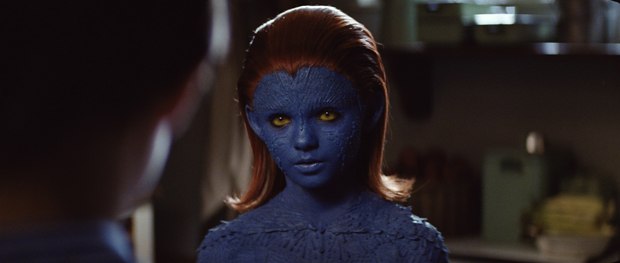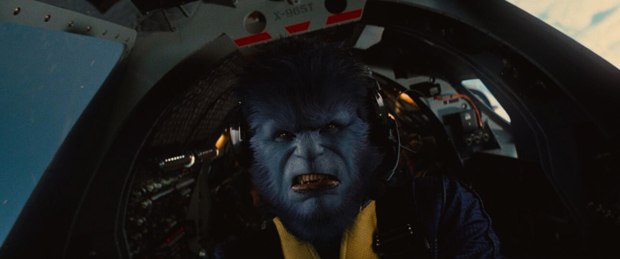Find out how they created some new and rebooted super powers for the latest X-Men prequel.
Check out the X-Men: First Class trailer and clips at AWNtv!
In X-Men: First Class, the origin of the X-Men world is born during the Cuban Missile Crisis of 1962, with Charles Xavier/Professor X (James McAvoy) and Erik Lehnsherr/Magneto meeting and becoming friends and rivals. The VFX challenge was to visually convey the nascent super powers in exciting and diverse ways, including Mystique (Jennifer Lawrence), Emma Frost (January Jones) and the supper baddie, Sebastian Shaw (Kevin Bacon).
John Dykstra, a legend in the VFX world, of course, is no stranger to comic superheroes (Spider-Man). But, as the visual effects designer, he was faced with some new challenges in turning out 1,150 shots: time and budgetary constraints and collaborating with global vendors (among them Digital Domain, Rhythm & Hues, MPC, Cinesite, Weta Digital, Method Studios and Luma Pictures).
"We had a very collapsed schedule," Dykstra concedes. "It was slightly less than a year and I've never done anything like that before (Spider-Man was frequently two years). It was a unique experience for me and I had my misgivings about it, but I really liked [director] Matthew Vaughn's irreverent approach to Kick-Ass. And one of the things I think that the superhero genre lacks is the ability to poke fun at itself. The characters are self-deprecating and I love the whole idea of it being the '60s. When he talked to me initially, he said he wanted it to have the feeling of a James Bond film, and I think it does. We shot in England in the wintertime, and, of course, this is an iconic American film, so the challenge was to find environments that either echoed the American environment feeling or that could be enhanced to look as though the stuff was shot here. The idea also was not to make a movie that looked like it was shot in the '60s…"
Dykstra got the most creative pleasure out of helping come up with the look of the iconic super powers. "In an odd way, it's like a poem: it wants to capture the essence of what the power is in a simple visual term that everybody can understand," he suggests. "Of course, some are cooler than others, so we ended up creating a very broad range of visual options for these characters, mostly in illustrations, and then we picked through the images we thought were most representative of the powers and who the characters were supposed to be.
"The most challenging thing was to come up with a range of super powers that didn't overlap each other hugely and that we could execute smoothly using Matthew's preference for original photography. We were also constrained by time in terms of preparing things from scratch."
For Shaw, the idea was to convey his ability to absorb energy like a big battery and then unleash it. All of Shaw's scenes were handled by Digital Domain, which principally focused on animating Shaw and handling certain CG environments such as the atrium and mirror room. DD's team consisted of Jay Barton (vfx supervisor), Nikos Kalaitzidis (digital effects supervisor), Bernd Angerer (animation supervisor), Brian Gazdik (effects animation supervisor) and Dan Platt (character modeling lead).
Not surprisingly, the technique for creating CG humans on this one was different from both Benjamin Button and Clu: "We only had a few months to do 100 shots," Kalaitzidis suggests. "We used witness cams so all the animation had to be done by hand for Kevin's performance, and he has quite a distinctive walk and swagger. The mirror room was shot on greenscreen and we had to recreate this digital environment with animated versions of Shaw and Magneto as well as CG body doubles to reflect in the mirrors infinitely. In the past, we used mental ray for CG heads, but here we switched to Vray because we had a lot of motion blur and reflections in the mirrors, so we wanted a renderer that could utilize both.
"With Kevin Bacon's head and face, we tried to do all the look dev within the final render, within lighting itself, and then do most of the tweaks in compositing when it came to the reflections," he continues. "So we knew we had to do this out of the box immediately."
For Mystique, Rhythm & Hues (under the supervision of Greg Steele) took her transition to a more sophisticated level, according to Dykstra. "In an odd way, the conceit is that when Mystique was younger she did this transformation in a slightly different way: the scales being slightly longer and the transformation being slightly showier than when she became the more mature Rebecca."
Rhythm & Hues also did Angel's wings (modeled after a dragon fly); however, Emma Frost, which posed another significant challenge. Dykstra says they made her like a faceted crystal as opposed to a piece of glass. "That was tough getting the refraction and reflection just right, and the sharpness of the edges so she was able to move without looking like she was made of jell-o or the polygon model of a human being. It's all algorithms: figuring out how much refraction to mix in, how much reflection to include and how much world noise to include as these facets adjust relative to one another for her to be able to move."
Meanwhile, Havok (Lucas Till) required a particular character arc to his light effect, which was done by Luma Pictures (supervised by Vince Cirelli). "He learns how to master its execution which starts out as rings that go in all directions like a light bulb," Dykstra adds.
Then there's Beast (Nicholas Hoult), which was created by MPC (under the supervision of Nicolas Aithadi). The thing that was unique about it was the lack of time spent studying the transformation," Dykstra offers. And that was Matthew's choice: he chose to make it much more of a cameo. And I think that was successful. Frankly, we've seen those kinds of things happened and a very smart choice on his part."
And what's the big take away on this X-Men prequel?
"There's good news and bad news," Dykstra suggests. "The good news is that we succeeded and I'm proud of the work; the bad news is that we succeeded, which means it will be the standard for how these movies will be made. We were very, very fortunate. We had a director willing to give us responsibility and to trust us to provide him with what he needed, and that decision-making process was collapsed. I hope this doesn't become the norm, but, having said that, I'm sure this will become the norm."
Bill Desowitz is senior editor of AWN & VFXWorld.











